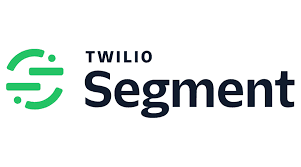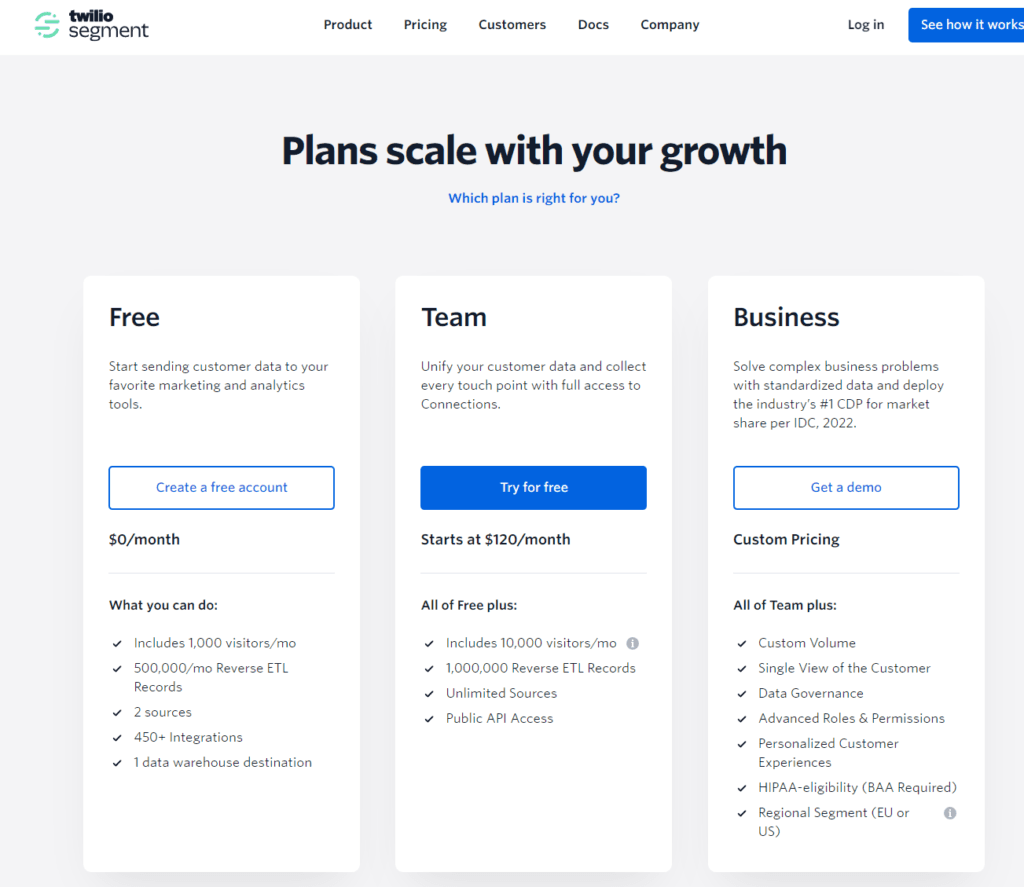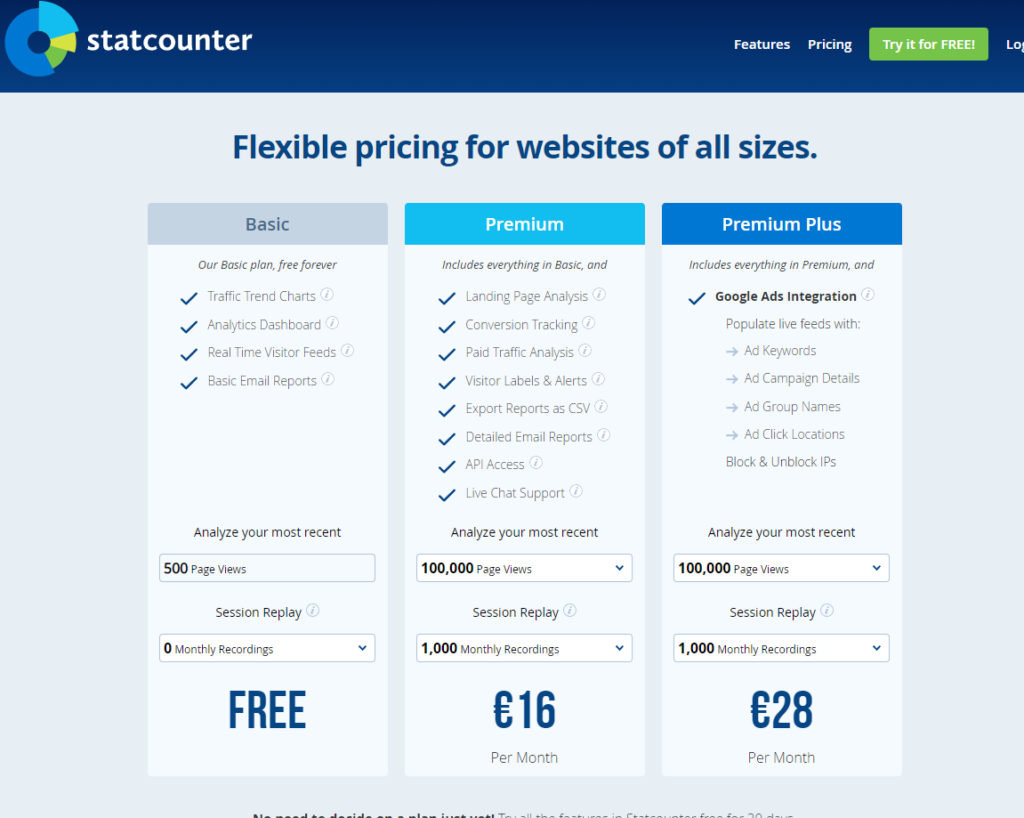In the digital age, where every interaction on your website can be a gold mine of insights, choosing the right analytics tool is more than just a technical decision—it’s a strategic one. Two notable contenders in this arena, Segment and Statcounter, offer distinct approaches to unraveling the stories behind your data. But how do you decide which tool is the compass that will guide you through the vast sea of digital analytics? Whether you’re a startup looking to understand your audience better or a seasoned marketer optimizing conversion paths, this comparison aims to shed light on the best analytics tool for your journey.
Segment | Statcounter |
|---|---|
| G2 Score – 4.6 out of 5 stars | G2 Score – 4.3 out of 5 stars |
| TrustRadius Score – 8.3/10 | TrustRadius Score – 9/10 |
Data Collection and Integration Capabilities
The backbone of any analytics tool is its ability to collect and integrate data from various sources. This capability determines not just the breadth of insights you can gather but also how actionable and comprehensive they are. Here’s how Segment and Statcounter stack up in this fundamental aspect.
Segment:
Segment positions itself as a powerful customer data platform, designed to collect, unify, and route your data to over 300 integrations. Its main strength lies in its ability to seamlessly integrate data from multiple sources—be it your website, app, CRM, or other marketing tools—and funnel it into your analytics, marketing, and data warehousing tools of choice. This extensive integration ecosystem makes Segment a versatile tool, particularly for businesses looking to leverage a broad range of analytics and marketing technologies.
It simplifies the data collection process, ensuring that all user interactions are captured and available for analysis in real-time, across all tools in your stack. This makes Segment ideal for organizations aiming for a holistic view of their customer journey across multiple touchpoints.
Segment offers a comprehensive solution for businesses looking to integrate a wide array of data sources and analytics tools. Its platform is designed to centralize and streamline the data collection process, making it a strong choice for larger organizations or those with complex analytics needs.
Statcounter:
Focused more narrowly on web traffic analytics, Statcounter provides real-time data collection, offering insights into visitor behavior, traffic sources, and engagement metrics directly from your website. While it may not boast the extensive integration capabilities of Segment, Statcounter excels in offering straightforward, actionable analytics for small to medium-sized websites. Its simplicity and ease of use make it a compelling choice for businesses and website owners who require direct, no-frills insights into their web traffic and user engagement. Statcounter allows for basic integration with websites through a simple tracking code, ensuring that businesses can start tracking visitor data with minimal setup.
Ease of Use and Learning Curve
The usability of an analytics tool and the time it takes to master its features can significantly impact its adoption and effectiveness within an organization. Let’s see how Segment and Statcounter compare in terms of user-friendliness and the learning curve.
Segment:
Segment’s comprehensive approach to data integration and management offers powerful capabilities but comes with a complexity that might be daunting for users new to analytics or without technical backgrounds. Setting up Segment to collect and route data across multiple sources and platforms requires a clear understanding of data schemas and integration points. While Segment offers extensive documentation and support resources to help users navigate these challenges, the initial setup and optimization of data flows can involve a steep learning curve. However, once in place, Segment’s infrastructure streamlines data collection and analysis, offering significant long-term benefits for organizations willing to invest the time in mastering the platform.
Segment, with its advanced data integration capabilities, caters to organizations looking for a comprehensive data platform and is best suited for users with a technical background or access to developer resources.
Statcounter:
Designed with simplicity in mind, Statcounter provides an intuitive analytics solution focused on key website metrics like traffic sources, visitor behavior, and engagement. Its straightforward setup process—typically just adding a piece of tracking code to your site—allows users to start collecting data quickly. The platform’s interface is clean and easy to navigate, making it accessible even to those with minimal analytics experience. Statcounter’s focus on essential web metrics, without the complexity of integrating multiple data sources, ensures a gentle learning curve, enabling users to glean actionable insights almost immediately.
Statcounter emerges as the more accessible option, particularly suited for small businesses, bloggers, or website owners who need straightforward insights into their site’s performance.

Related: Check out our free SEO suite

Customization and Flexibility
Customization and flexibility in an analytics tool allow you to mold its capabilities around your specific goals, ensuring that the insights you gather are directly applicable to your business strategies. Here’s how Segment and Statcounter compare in offering customizable and flexible analytics solutions.
Segment:
One of Segment’s core strengths is its high degree of customization and flexibility. The platform is designed to collect data from any source and send it to over 300 destinations, tailored to your specific analytics, marketing, and data warehousing needs. This extensive integration capability ensures that Segment can adapt to virtually any data strategy, offering businesses the flexibility to change tools and platforms without losing the continuity of their data collection and analysis efforts. Additionally, Segment allows for the customization of data tracking and collection, enabling businesses to capture the precise events and user actions that matter most to their analysis.
Statcounter:
Focused on providing straightforward web analytics, Statcounter offers less in the way of customization compared to a platform like Segment. Its strength lies in simplicity and ease of use, with the primary focus on delivering essential website metrics such as page views, visitor counts, and traffic sources. While Statcounter does offer some level of flexibility in terms of what can be tracked and reported, its capabilities are designed to meet the needs of users looking for basic, no-frills analytics. This makes it an excellent choice for smaller websites or businesses that require simple and direct insights without the need for extensive customization.
Industry Application and Use Cases
The versatility of an analytics platform in catering to the unique demands of different industries and providing solutions for common use cases within those sectors is crucial. Here’s how Segment and Statcounter adapt to various industry needs and applications. The relevance of an analytics tool to your specific industry and the common use cases it supports can significantly influence its effectiveness and value to your business.
Segment:
Segment’s comprehensive data integration and management capabilities make it highly adaptable to a wide range of industries, from e-commerce and SaaS to media and entertainment. Its strength lies in its ability to collect and unify customer data from multiple touchpoints, providing a holistic view of the customer journey. This makes Segment particularly valuable for businesses focused on enhancing customer experiences, personalizing marketing efforts, and optimizing product development based on detailed user insights.
Common use cases include building unified customer profiles, implementing cross-channel marketing campaigns, and conducting in-depth analytics to drive strategic decision-making. Segment’s flexibility in handling complex data scenarios makes it a preferred choice for businesses looking for a customizable analytics backbone that can support diverse data strategies.
Statcounter:
With its focus on web traffic analytics, Statcounter is particularly well-suited for small to medium-sized businesses, bloggers, and content creators looking to understand and improve their website’s performance. It excels in providing real-time insights into page views, visitor behavior, and traffic sources, enabling users to quickly identify trends, track marketing campaign effectiveness, and make data-driven adjustments to their content and SEO strategies.
While Statcounter may not offer the breadth of integration or depth of analysis found in more comprehensive platforms like Segment, its simplicity and focus on essential web analytics make it highly effective for its target use cases. Statcounter is a practical tool for businesses and individuals seeking straightforward analytics solutions to optimize their online presence.
Pricing
The pricing structures of Segment and Statcounter reflect their targeted user bases and the depth of functionality they offer. Understanding the value proposition of each can help clarify which tool might best serve your needs.
Segment:

Segment’s pricing model is designed to scale with the size and complexity of your business. It offers a free tier with limited features, suitable for startups or small businesses just beginning to structure their data collection efforts. As businesses grow and their data needs become more sophisticated, Segment provides several paid plans that expand data volume limits and access to more advanced features, including integrations and data warehousing capabilities.
The value proposition of Segment lies in its ability to unify and streamline data flow across a multitude of tools and platforms, essentially serving as the backbone for a comprehensive data strategy. For businesses investing in a data-driven approach across multiple channels and platforms, Segment offers a scalable solution that grows with your needs, albeit at a cost that reflects its broad utility and integration capabilities.
Statcounter:

Aimed at providing straightforward web analytics, Statcounter’s pricing is relatively simple and accessible, with a free tier for basic tracking and paid plans that increase data history and offer more detailed reporting features. The focus here is on delivering immediate, actionable insights into website performance without the complexity or cost associated with more comprehensive analytics platforms.
Statcounter’s value proposition appeals to small businesses, bloggers, and individual website owners who need to monitor site traffic and user behavior without a significant financial investment. It offers the essential tools for website optimization and user experience improvements in a budget-friendly package.
Conclusion
In conclusion, the decision between Segment and Statcounter hinges on understanding your business’s unique needs, industry requirements, and the specific use cases you aim to address with analytics.
Segment stands out as a powerful customer data platform ideal for businesses that require a comprehensive, integrable solution capable of unifying data across multiple touchpoints and platforms. Its adaptability and extensive integration capabilities make it suitable for a wide range of industries, especially those focused on building detailed customer profiles, enhancing personalized marketing efforts, and driving data-informed product development. Segment is particularly valuable for larger organizations or those with complex, multi-channel data strategies seeking to leverage analytics for deep insights and strategic decision-making.
Statcounter, on the other hand, offers a streamlined and accessible web analytics solution, perfect for small to medium-sized businesses, bloggers, and content creators. Its focus on essential web traffic metrics and user behavior insights provides immediate value for optimizing website performance, understanding audience engagement, and improving content and SEO strategies. Statcounter’s simplicity and ease of use make it a compelling option for those who need straightforward, actionable analytics without the complexity or investment required by more comprehensive platforms.
Read Next:
- GetResponse vs Zoho Campaigns: The Best Email Marketing Tool for 2024
- AWeber vs ActiveCampaign: The Best Email Marketing Tool
- Constant Contact vs Campaigner: Best Email Marketing Tool
- GetResponse vs Omnisend: The Best Email Marketing Tool for 2024
- AWeber vs Benchmark Email: The Best Email Marketing Tool






















Comments are closed.